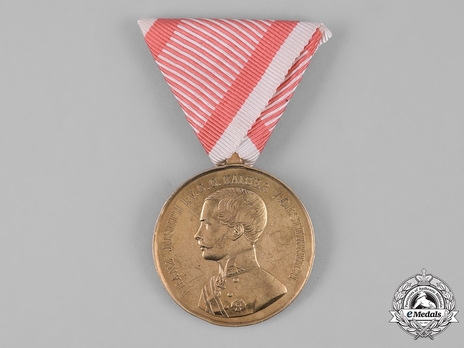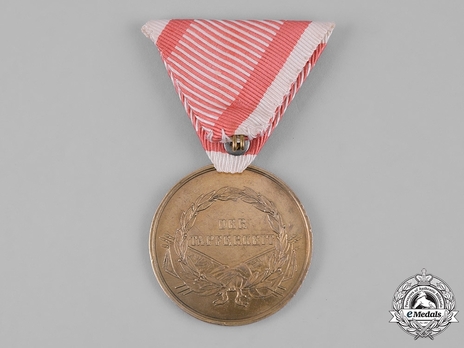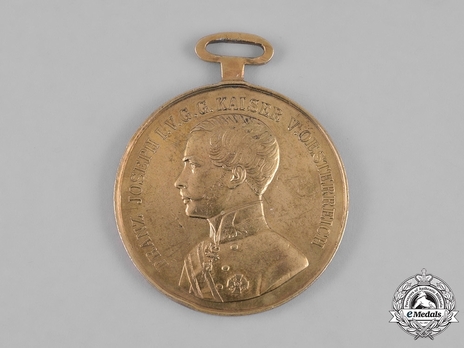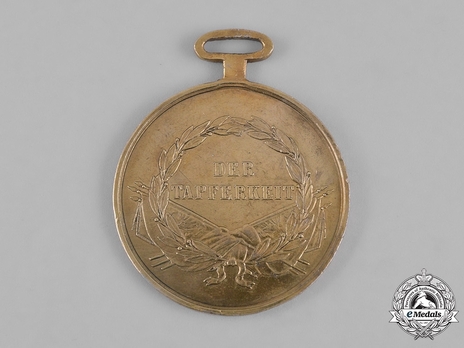Bravery Medal "DER TAPFERKEIT", Type VI, Gold Medal
SKU: 02.AUT.0115.101.01
Estimated market value:




Estimated market value:
Attributes
History
The Bravery Medal was established by Emperor Joseph II on July 19, 1789. It was originally known as a Medal of Honour or votive medal. This medal was likely created following the 8th Austro-Turkish War (1788-1791), where the Austrian army was introduced to the existence of Russian votive medals, and deemed it necessary to have their own that could be awarded to their ranks of Feldwebel (infantry) and Wachtmeister (cavalry) downwards in all branches of service.
The Bravery Medal was awarded to individuals who personally carried out a particularly brave deed before the enemy to benefit the service, achieved a mission or aided the result of an officer or comrade or a trophy/ military materials form danger. The individuals’ actions must have been witnessed by another person to be considered. It was created in in two levels, a gold medal, awarded for ‘most exceptional deeds’ and a silver medal. They could both be awarded to Austrians and Foreigners. For repeated actions of bravery, a recipient of the silver medal could be awarded the gold medal, and the silver medal was to be returned. A recipient of the gold medal would be rewarded with money for additional acts of bravery. It was awarded on a red and white ribbon, likely based off the Order of Maria Theresa. The silver medal was accompanied by half the recipient’s salary, and the gold medal was accompanied by a doubled salary.
In May 1809, new regulations were set in place. The most obvious alteration was the change of name to the Military Bravery Medal. It was also decided that after a recipient’s death the medal would be returned by the family in exchange for the monetary value, allowing for the medals to be reissued.
In August 1848, Emperor Ferdinand I created another class of the Bravery Medal, the “Silver Bravery Medal II Class.” It did not have any financial benefits but could be awarded to k.u.k soldiers during peacetime. One year later, under the leadership of Emperor Franz Joseph I, the rule that the lower class medal had to be returned was rescinded, allowing for a recipient to wear both awards and obtain the salary allowance for both as well. Beginning in 1898, it was announced that anyone with a Gold or Silver Bravery Medal I Class would receive the monetary allowance for the remainder of his life.
During the First World War, the financial allowances were altered to be 30 Kronen for the Gold medal, 15 Kronen for the Silver medal I Class and 7 Kronen, 50 Heller for the Silver medal II Class.
In 1915, the “Bronze Bravery Medal for Other Ranks” was created. Later that year, the people eligible for the award was expanded to include civilians and women in the k.u.k army.
In 1916, due to the long duration of the war, individuals could be awarded multiple awards of the same class. This was denoted by silver bars worn on the ribbon. However, the financial award was given for the first medal awarded.
On September 15, 1917 Emperor Karl I created an Imperial Decree which granted a special level of the Bravery medal. It was now possible for officers to be awarded the gold or silver bravery medal I Class, known as the Gold/Silver Bravery Medals I Class for Officers. If an individual had already received the medal as an officer, they were distinguished by a gold or silver ‘K’ on the ribbon.
The ‘golden’ level Bravery Medal was only awarded 1,900 times between 1789-1901. During the war, 4,738 were awarded to aspiring officers and other ranks, 2,104 of which were made of bronze. The Bravery Medal for Officers can be regarded as even more rare because of how late it was introduced in the war.
The Bravery Medal was officially discontinued at the end of the First World War, but like many Austro-Hungarian awards, was retroactively awarded by the Heller Commission. However, financial allowances were still payed after Austria’s annexation from Germany. In 1939, recipients of the Gold Medal were honoured again on the occasion of the 25th anniversary of the Battle of Tannenberg. They were promoted in rank. The last recipient of the Old-Austrian Bravery Medal died in 2002.
The Type VI (Franz Joseph I 1859-1866) medals were conferred to reward service in the second half of the War of 1866. The I Class Gold Medal and I Class Silver Medal did not have stamps. It presents the portrait of the emperor on the obverse facing right, and the reverse depicts a bundle of trophies and the inscription DER TAPFERKEIT (For Bravery), surrounded by a laurel wreath.
The Gold Medal was only awarded for extremely brave and risky service.

Versions
$750 USD
Gold
Obv: FRANZ JOSEPH I. V.G.G. KAISER V. OESTERREICH Rev: DER TRAPFERKEIT
40mm
This profile features Franz Joseph I facing left with a moustache.


Comments
Sign in to comment and reply.


Scroll Top